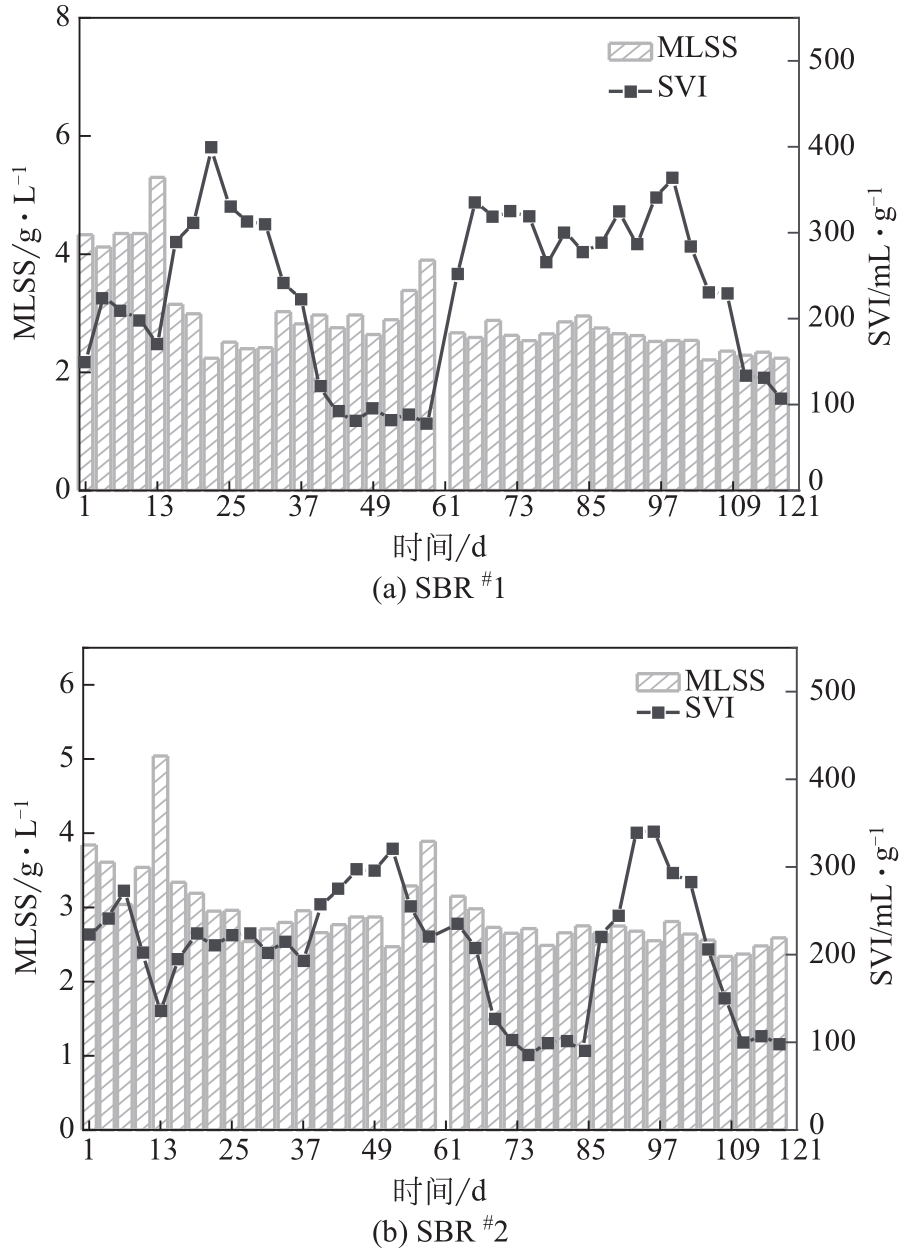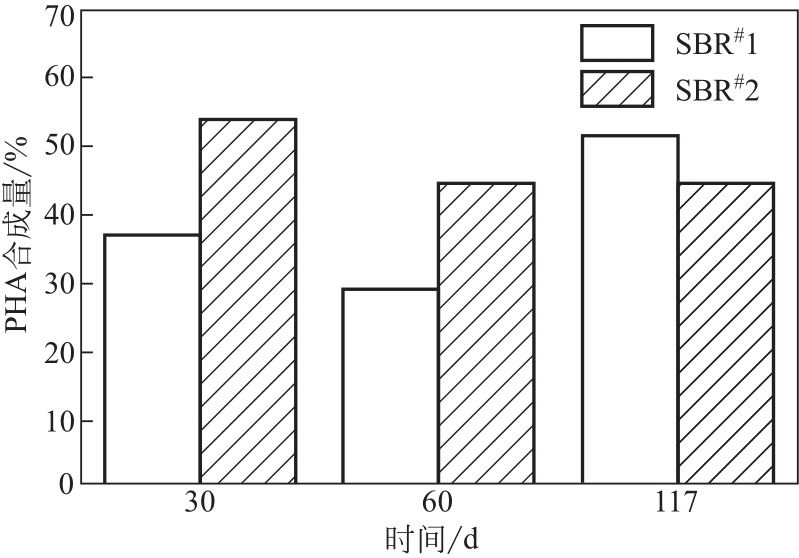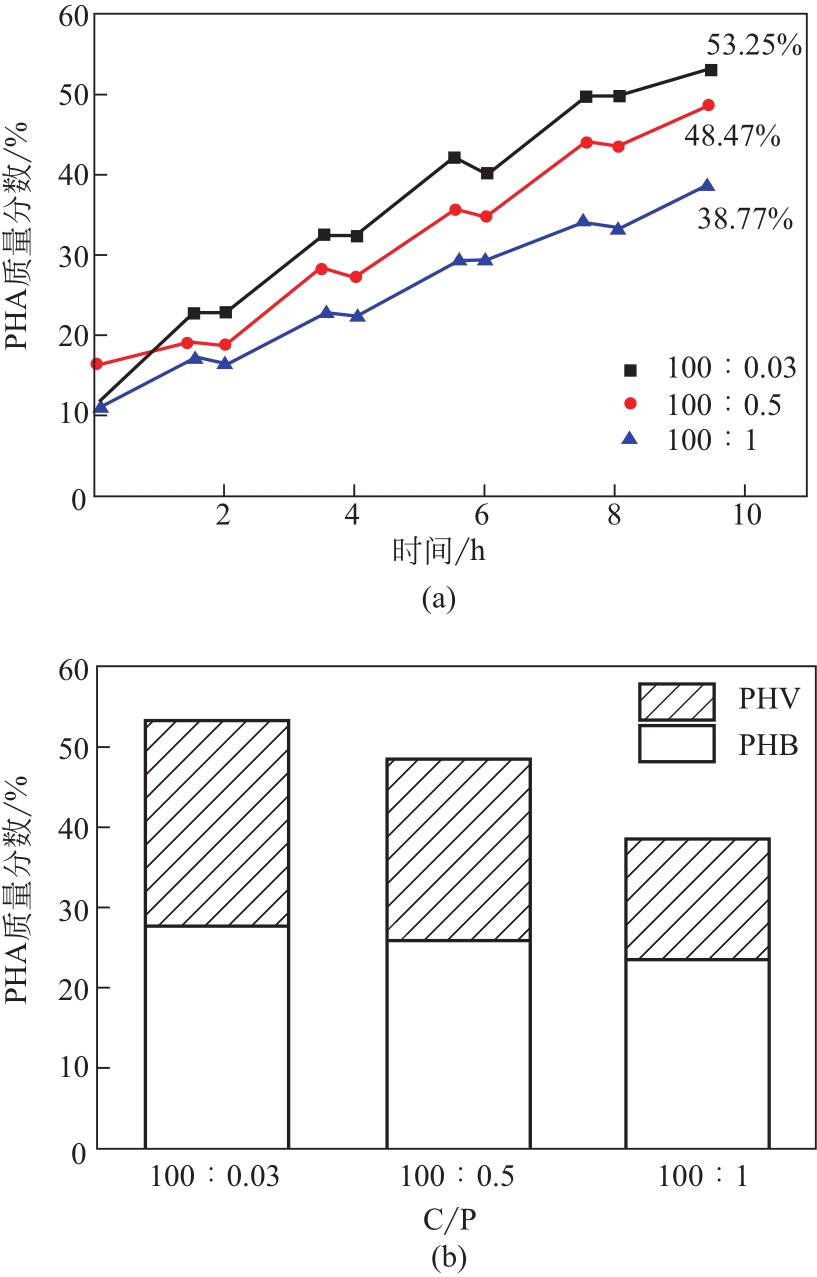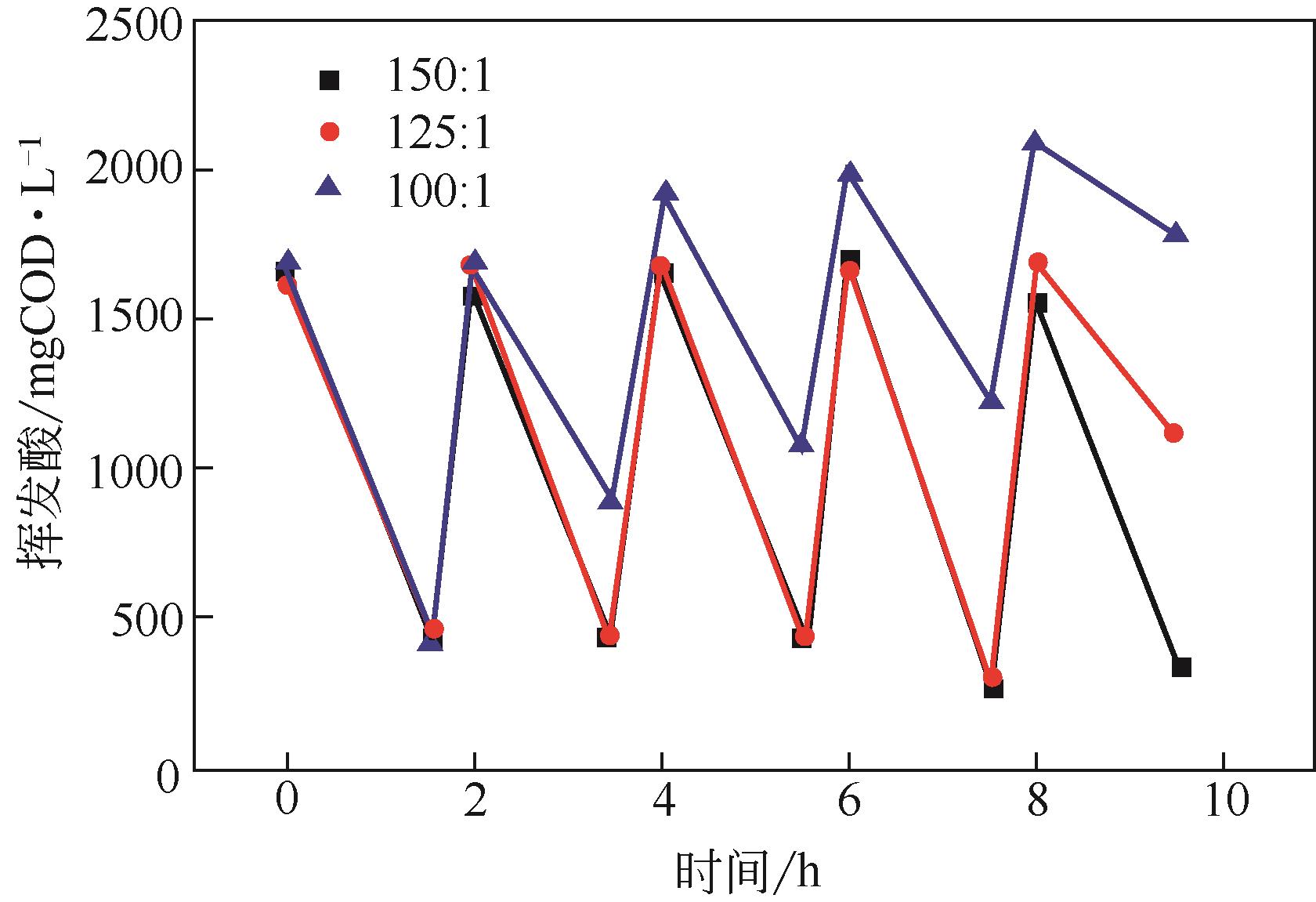Chemical Industry and Engineering Progress ›› 2022, Vol. 41 ›› Issue (2): 1017-1024.DOI: 10.16085/j.issn.1000-6613.2021-0515
• Resources and environmental engineering • Previous Articles Next Articles
Synthesis of PHA by mixed microorganisms using simulative hydrolysate liquid from the excess sludge by APG combined with FNA pretreatment
WANG Na1( ), SONG Xiulan1(
), SONG Xiulan1( ), ZAN Botao2
), ZAN Botao2
- 1.College of Environmental Science and Engineering, Taiyuan University of Technology, Taiyuan 030024, Shanxi, China
2.University of Washington, Seattle, USA
-
Received:2021-03-15Revised:2021-06-12Online:2022-02-23Published:2022-02-05 -
Contact:SONG Xiulan
复合菌群利用模拟APG协同FNA预处理剩余污泥水解液合成PHA
- 1.太原理工大学环境科学与工程学院,山西 太原 030024
2.University of Washington, Seattle, USA
-
通讯作者:宋秀兰 -
作者简介:王娜(1996—),女,硕士研究生,研究方向为水污染控制和水质安全保障。E-mail:wangna96666@163.com 。 -
基金资助:山西省应用基础研究计划(201901D111067);山西省国际科技合作计划(201803D421098)
CLC Number:
Cite this article
WANG Na, SONG Xiulan, ZAN Botao. Synthesis of PHA by mixed microorganisms using simulative hydrolysate liquid from the excess sludge by APG combined with FNA pretreatment[J]. Chemical Industry and Engineering Progress, 2022, 41(2): 1017-1024.
王娜, 宋秀兰, 昝博韬. 复合菌群利用模拟APG协同FNA预处理剩余污泥水解液合成PHA[J]. 化工进展, 2022, 41(2): 1017-1024.
share this article
Add to citation manager EndNote|Ris|BibTeX
URL: https://hgjz.cip.com.cn/EN/10.16085/j.issn.1000-6613.2021-0515
| 成分 | 占比/% | 成分 | 占比/% |
|---|---|---|---|
| 乙酸 | 42.59 | 丙酸 | 18.77 |
| 丁酸 | 18.73 | 戊酸 | 19.91 |
| 成分 | 占比/% | 成分 | 占比/% |
|---|---|---|---|
| 乙酸 | 42.59 | 丙酸 | 18.77 |
| 丁酸 | 18.73 | 戊酸 | 19.91 |
| 成分 | 质量/体积 | 成分 | 质量/体积 |
|---|---|---|---|
| 乙酸钠 | 6.55g | 磷酸二氢钾 | 0.5268g |
| 丙酸钠 | 1.93g | 氯化钙 | 1g |
| 丁酸 | 1.30mL | 硫酸镁 | 2.5g |
| 戊酸 | 1.256mL | 硫脲 | 0.4g |
| 氯化铵 | 2.293g | 微量元素储备液 | 5mL |
| 成分 | 质量/体积 | 成分 | 质量/体积 |
|---|---|---|---|
| 乙酸钠 | 6.55g | 磷酸二氢钾 | 0.5268g |
| 丙酸钠 | 1.93g | 氯化钙 | 1g |
| 丁酸 | 1.30mL | 硫酸镁 | 2.5g |
| 戊酸 | 1.256mL | 硫脲 | 0.4g |
| 氯化铵 | 2.293g | 微量元素储备液 | 5mL |
| 名称 | 浓度/g·L-1 | 名称 | 浓度/g·L-1 |
|---|---|---|---|
| ZnSO4·7H2O | 0.12 | MnCl·H2O | 0.12 |
| KI | 1.18 | CuSO4·5H2O | 0.03 |
| H3BO4 | 0.15 | NaMoO4·2H2O | 0.06 |
| CaCl2·6H2O | 0.15 | FeCl·6H2O | 1.5 |
| 名称 | 浓度/g·L-1 | 名称 | 浓度/g·L-1 |
|---|---|---|---|
| ZnSO4·7H2O | 0.12 | MnCl·H2O | 0.12 |
| KI | 1.18 | CuSO4·5H2O | 0.03 |
| H3BO4 | 0.15 | NaMoO4·2H2O | 0.06 |
| CaCl2·6H2O | 0.15 | FeCl·6H2O | 1.5 |
| 指标 | 浓度 |
|---|---|
| PO | 8.23mg/L |
| NH | 187.97mg/L |
| 溶解性多糖 | 82.35mg/L |
| 溶解性蛋白质 | 295.11mg/L |
| COD | 3138.79mg/L |
| SCFAs | 2765.82mgCOD/L |
| 指标 | 浓度 |
|---|---|
| PO | 8.23mg/L |
| NH | 187.97mg/L |
| 溶解性多糖 | 82.35mg/L |
| 溶解性蛋白质 | 295.11mg/L |
| COD | 3138.79mg/L |
| SCFAs | 2765.82mgCOD/L |
| 碳源类型 | 周期内PHA 合成量/% | 批次合成PHA累积合成量/% | 参考 文献 |
|---|---|---|---|
| 粗甘油 | 25.93 | 36.59 | [ |
| 花生渣发酵挥发酸 | — | 34.87 | [ |
| 污泥碱性厌氧消化液 | — | 56.5 | [ |
| 乙酸 | — | 56.3 | [ |
| 乳品废水发酵液 | — | 43.11 | [ |
| 乙酸盐 | — | 78.5 | [ |
| 乙酸钠 | — | 59 | [ |
| 碳源类型 | 周期内PHA 合成量/% | 批次合成PHA累积合成量/% | 参考 文献 |
|---|---|---|---|
| 粗甘油 | 25.93 | 36.59 | [ |
| 花生渣发酵挥发酸 | — | 34.87 | [ |
| 污泥碱性厌氧消化液 | — | 56.5 | [ |
| 乙酸 | — | 56.3 | [ |
| 乳品废水发酵液 | — | 43.11 | [ |
| 乙酸盐 | — | 78.5 | [ |
| 乙酸钠 | — | 59 | [ |
| 1 | LEE S Y. Bacterial polyhydroxyalkanoates[J]. Biotechnology and Bioengineering, 2000, 49(1): 1-14. |
| 2 | KEDIA G, PASSANHA P,dINSDALE R M, et al. Addressing the challenge of optimum polyhydroxyalkanoate harvesting: monitoring real time process kinetics and biopolymer accumulation usingdielectric spectroscopy[J]. Bioresource Technology, 2013, 134: 143-150. |
| 3 | CHEN Y G, LIU K, SU Y L, et al. Continuous bioproduction of short-chain fatty acids from sludge enhanced by the combined use of surfactant and alkaline pH[J]. Bioresource Technology, 2013, 140: 97-102. |
| 4 | ZHANG C, CHEN Y G. Simultaneous nitrogen and phosphorus recovery from sludge-fermentation liquid mixture and application of the fermentation liquid to enhance municipal wastewater biological nutrient removal[J]. Environmental Science & Technology, 2009, 43(16): 6164-6170. |
| 5 | WANG Q L, YE L, JIANG G M, et al. Free nitrous acid (FNA)-based pretreatment enhances methane production from waste activated sludge[J]. Environmental Science & Technology, 2013, 47(20): 11897-11904. |
| 6 | ZHAO J W, WANGd B, LI X M, et al. Free nitrous acid serving as a pretreatment method for alkaline fermentation to enhance short-chain fatty acid production from waste activated sludge[J]. Water Research, 2015, 78: 111-120. |
| 7 | PIJUAN M, WANG Q, YE L, et al. Improving secondary sludge biodegradability using free nitrous acid treatment[J]. Bioresource Technology, 2012, 116: 92-98. |
| 8 | 杨黎俊. 亚硝酸预处理协同烷基糖苷处理剩余污泥产酸的研究[D]. 太原: 太原理工大学, 2019. |
| YANG Lijun. Enhanced production of short-chain fatty acids from excess sludge by combined free nitrous acid and alkyl polyglucoside treatment[D]. Taiyuan: Taiyuan University of Technology, 2019. | |
| 9 | 国家环保局本书编委会.水和废水监测分析方法[M]. 4版.北京:中国环境科学出版社,1989. |
| Editorial Committee of National Environmental Protection Bureau. Monitoring and analysis method of water and wastewater[M]. 4th ed. Beijing: China Environmental Science Press, 1989. | |
| 10 | 刘莹. 混合菌群利用粗甘油合成聚羟基烷酸酯(PHA)的研究[D]. 哈尔滨: 哈尔滨工业大学, 2018. |
| LIU Ying. Study on the polyhydroxyalkanoate (PHA) production by mixed culture using crude glycerol as substrate[D]. Harbin: Harbin Institute of Technology, 2018. | |
| 11 | 刘煜. 活性污泥合成PHA的工艺条件优化[D]. 广州: 广州大学, 2020. |
| LIU Yu. Optimization of process conditions for PHA synthesis from activated sludge[D]. Guangzhou: Guangzhou University, 2020. | |
| 12 | 蔡萌萌. 剩余活性污泥中的微生物利用实际废液合成聚羟基烷酸酯[D]. 哈尔滨: 哈尔滨工业大学, 2009. |
| CAI Mengmeng. Polyalkanoates synthesis from real waste by microorganisms in excess sludge[D]. Harbin: Harbin Institute of Technology, 2009. | |
| 13 | 李伟. 碳源对活性污泥合成聚羟基烷酸酯影响的研究[D].上海:同济大学, 2009. |
| LI Wei. Study on the effect of carbon source on the synthesis of polyhydroxyalkanoate from activated sludge[D]. Shanghai: Tongji University, 2009. | |
| 14 | CHAKRAVARTY P, MHAISALKAR V, CHAKRABARTI T. Study on poly-hydroxyalkanoate (PHA) production in pilot scale continuous mode wastewater treatment system[J]. Bioresource Technology, 2010, 101(8): 2896-2899. |
| 15 | SERAFIM L S, LEMOS P C, OLIVEIRA R, et al. Optimization of polyhydroxybutyrate production by mixed cultures submitted to aerobic dynamic feeding conditions[J]. Biotechnology and Bioengineering, 2004, 87(2): 145-160. |
| 16 | 郭子瑞. 基于动态间歇排水瞬时补料的活性污泥合成PHA新工艺研究[D]. 哈尔滨: 哈尔滨工业大学, 2016. |
| GUO Zirui. Research on new process of PHA production using activated sludge based ondynamic pulsedischarge-aerobicdynamic feeding mode[D]. Harbin: Harbin Institute of Technology, 2016. | |
| 17 | VILLANO M, BECCARI M,DIONISI D, et al. Effect of pH on the production of bacterial polyhydroxyalkanoates by mixed cultures enriched under periodic feeding[J]. Process Biochemistry, 2010, 45(5): 714-723. |
| 18 | CHUA A S, TAKABATAKE H, SATOH H, et al. Production of polyhydroxyalkanoates (PHA) by activated sludge treating municipal wastewater: effect of pH, sludge retention time (SRT), and acetate concentration in influent[J]. Water Research, 2003, 37(15): 3602-3611. |
| 19 | KOURMENTZA C, KORNAROS M. Biotransformation of volatile fatty acids to polyhydroxyalkanoates by employing mixed microbial consortia: the effect of pH and carbon source[J]. Bioresource Technology, 2016, 222: 388-398. |
| 20 | 陈志强, 田婷, 温沁雪, 等. 限氮和限磷对活性污泥合成聚羟基烷酸的影响[J]. 环境工程学报, 2010, 4(4): 771-775. |
| CHEN Zhiqiang, TIAN Ting, WEN Qinxue, et al. Impact of nitrogen limitation and phosphorus limitation on PHA synthesis by activated sludge[J]. Chinese Journal of Environmental Engineering, 2010, 4(4): 771-775. | |
| 21 | KORKAKAKI E, LOOSDRECHT M C M VAN, KLEEREBEZEM R. Impact of phosphate limitation on PHA production in a feast-famine process[J]. Water Research, 2017, 126: 472-480. |
| 22 | TU W, ZHANG D, WANG H. Polyhydroxyalkanoates (PHA) production from fermented thermal-hydrolyzed sludge by mixed microbial cultures: the link between phosphorus and PHA yields[J]. Waste Management, 2019, 96: 149-157. |
| 23 | WEN Qinxue, CHEN Zhiqiang, TIAN Ting, et al. Effects of phosphorus and nitrogen limitation on PHA production in activated sludge[J]. Journal of Environmental Science, 2010, 22(10): 1602-1607. |
| 24 | 贾倩倩. 复合菌群利用模拟污泥水解液合成聚羟基脂肪酸酯的研究[D]. 北京: 清华大学, 2013. |
| JIA Qianqian. Study on synthesis of polyhydroxyalkanoates (PHA) by bacterial consortium from simulated excess sludge fermentation liquid[D]. Beijing: Tsinghua University, 2013. | |
| 25 | 赵丽智. 活性污泥混合菌群利用污泥水解液合成PHA的性能研究[D]. 哈尔滨: 哈尔滨工业大学, 2017. |
| ZHAO Lizhi. Research on polyhydroxyalkanote production performance by mixed cultures from activated sludge[D]. Harbin: Harbin Institute of Technology, 2017. |
| [1] | WANG Xueting, GU Xia, XU Xianbao, ZHAO Lei, XUE Gang, LI Xiang. Effectiveness of hydrothermal pretreatment on valeric acid production during food waste fermentation [J]. Chemical Industry and Engineering Progress, 2023, 42(9): 4994-5002. |
| [2] | CHEN Xiangyu, BIAN Chunlin, XIAO Benyi. Research progress on temperature phased anaerobic digestion technology [J]. Chemical Industry and Engineering Progress, 2023, 42(9): 4872-4881. |
| [3] | XI Yonglan, WANG Chengcheng, YE Xiaomei, LIU Yang, JIA Zhaoyan, CAO Chunhui, HAN Ting, ZHANG Yingpeng, TIAN Yu. Research progress on the application of micro/nano bubbles in anaerobic digestion [J]. Chemical Industry and Engineering Progress, 2023, 42(8): 4414-4423. |
| [4] | LU Shaojie, LIU Jia, JI Qianzhu, LI Ping, HAN Yueyang, TAO Min, LIANG Wenjun. Preparation of diatomaceous earth-based composite filler and its xylene removal performance by a biotrickling filter [J]. Chemical Industry and Engineering Progress, 2023, 42(7): 3884-3892. |
| [5] | LIU Yang, YE Xiaomei, MIAO Xiao, WANG Chengcheng, JIA Zhaoyan, CAO Chunhui, XI Yonglan. Pilot-scale process research on dry digestion of rural organic household waste under ammonia stress [J]. Chemical Industry and Engineering Progress, 2023, 42(7): 3847-3854. |
| [6] | ZHUANG Jie, XUE Jinhui, ZHAO Bincheng, ZHANG Wenyi. Organic binding mechanism of heavy metals and humus during anaerobic digestion of pig manure [J]. Chemical Industry and Engineering Progress, 2023, 42(6): 3281-3291. |
| [7] | LI Baixue, XIN Xin, ZHU Yumeng, LIU Qin, LIU Xin. Construction of sulfur autotrophic short-cut denitrification and anaerobic ammonium oxidation (SASD-A) coupling system and effect mechanisms of influent S/N ratio on denitrification process [J]. Chemical Industry and Engineering Progress, 2023, 42(6): 3261-3271. |
| [8] | HUANG Yue, ZHAO Lixin, YAO Zonglu, YU Jiadong, LI Zaixing, SHEN Ruixia, AN Kemeng, HUANG Yali. Research progress in directed bioconversion of lactic acid and acetic acid from wood lignocellulosic wastes [J]. Chemical Industry and Engineering Progress, 2023, 42(5): 2691-2701. |
| [9] | FAN Sihan, YU Guoxi, LAI Chaochao, HE Huan, HUANG Bin, PAN Xuejun. Effect of abiotic modification on photochemical activity of anaerobic microbial products [J]. Chemical Industry and Engineering Progress, 2023, 42(4): 2180-2189. |
| [10] | ZHAO Xingcheng, JIA Fangxu, JIANG Weiyu, CHEN Jiayi, LIU Chenyu, YAO Hong. Redox mediators-mediated anaerobic ammonium oxidation process for biological nitrogen removal: a review [J]. Chemical Industry and Engineering Progress, 2023, 42(3): 1606-1617. |
| [11] | MENG Xiaoshan, TANG Zijian, CHEN Lin, HUHE Taoli, ZHOU Zhengzhong. Research progress of the early warning and regulation techniques for excessive acidification in the anaerobic digestion system [J]. Chemical Industry and Engineering Progress, 2023, 42(3): 1595-1605. |
| [12] | WU Xinbo, DANG Hongzhong, MA Jiao, YAN Yuan, ZENG Tianxu, LI Weiwei, ZHANG Guozhen, CHEN Yongzhi. Effect of denitrifying phosphorus removal under short-cut nitrification mode with A2/O-BAF process [J]. Chemical Industry and Engineering Progress, 2023, 42(2): 1089-1097. |
| [13] | ZHANG Han, ZHANG Xiaojing, MA Bingbing, NAI Can, LIU Shuoshuo, MA Yongpeng, SONG Yali. Feasibility of starting anammox process with municipal waste sludge as seed sludge [J]. Chemical Industry and Engineering Progress, 2023, 42(2): 1080-1088. |
| [14] | ZHU Jiaxin, ZHU Wenzhe, XU Jun, XIE Jing, WANG Wenbiao, XIE Li. Enhancement of anaerobic digestion under antibiotics stress via conductive materials application: A review [J]. Chemical Industry and Engineering Progress, 2023, 42(2): 1008-1019. |
| [15] | LIU Yali, ZHANG Hongwei, KANG Xiaorong. Effect and mechanisms of microplastics on anaerobic digestion of sludge [J]. Chemical Industry and Engineering Progress, 2022, 41(9): 5037-5046. |
| Viewed | ||||||
|
Full text |
|
|||||
|
Abstract |
|
|||||








